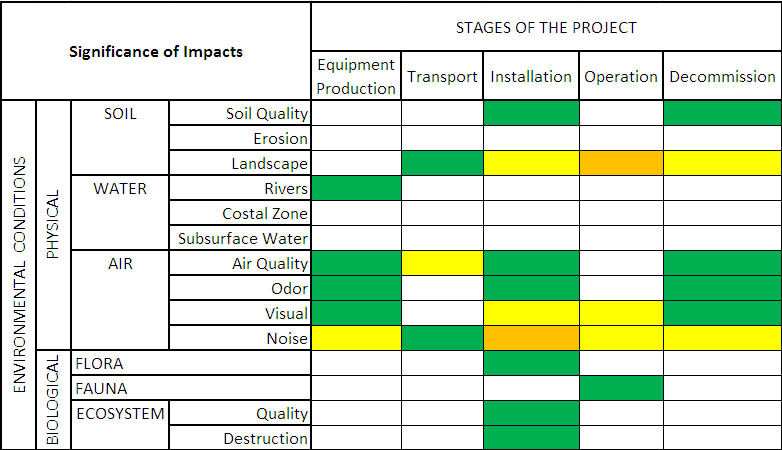
Menu:
Environmental Impacts
Any project development has impacts on the environment, which can either be positive or negative. Identification of the impacts is important in the early stages of the project to assess whether they are reasonable, and if any mitigation measures can be made. The community will have to make a decision whether these impacts are acceptable to them.
There are various methods used to predict the environmental impact of a project, the Leopold matrix [1] is the method which has been used in this project. It is a two-dimensional matrix where the stages of the project are assessed in relation to the environmental factors which may be affected during the execution of the project.
The stages of the project are listed on the horizontal axis of the matrix: equipment production, building operations, energy supply, transportation and installation. The environmental factors are listed on the vertical axis and are classified into two major groups: Physical and Biological.
The Leopold matrix works as follows: The cell where each stage of the project intersects with an environmental impact is coloured according to the significance of the impact. The level of significance is represented of traffic light grading system described below.
The matrix identifies impacts which may occur as a result of the development, and their level of significance. It is possible to introduce mitigation measures to reduce impacts on the environment.

The following matrix has been developed to suit the specific needs of this project.

Figure 1
In figure 1, assumptions of the impacts caused by the implementation of the match selection from our sizing technique are shown. It has been assumed that the community will have the knowledge to perform some efficiency improvement before installing the renewable devices in line with the recommendations concluded from the project, so efficiency improvements are not considered in the matrix. This matrix could be used for any community development of this type.
There is difference between long-term or short-term impacts. The significance of a long term impact can be considered to be more. For example the operational impacts will last for the life of the development; this can be over 25 years. The short term impacts may last only days or weeks.
When the equipment is in operation, they have little or no impact to the environment and the lifespan is an average of 25 years. Since the equipment will be in operation for a long period, it has an effect on reducing the cumulative impacts throughout the life of the development. In addition, executing the project reduces the carbon emission from electricity-generation by fossil fuels.
Some of the general trends which may reduce the significance of impacts in the future are: technology improvement, more vehicles running on electricity, reduction in the noise from wind turbines, lower demand leading to lower consumption and supply, and more efficient methods of manufacturing equipment.
However, if the need for resizing equipment in the future occurs, then the impacts from equipment production, transportation, installation and decommissioning will increase; the opposite effect of the other beneficial trends.
The specific outcome of the impact assessment will vary greatly depending on the specifics of the development. This matrix is a guideline for the types of impacts which may occur and the effects which the trends discussed in this project will have on them.
References
[1] Food and Agriculture Organization of the United Nations (FAO) Forestry Department (1996)Environmental impact assessment and environmental auditing in the pulp and paper industry. Accessible at: http://www.fao.org/docrep/005/V9933E/V9933E02.htm (Accessed 3/5/12).
[2] Leopold, L. B., Clarke, F. E., Hanshaw, B. B. and Balsley J. R. (1971)A Procedure for Evaluating Environmental Impact Accessible at: http://eps.berkeley.edu/people/lunaleopold (Accessed 3/5/12).